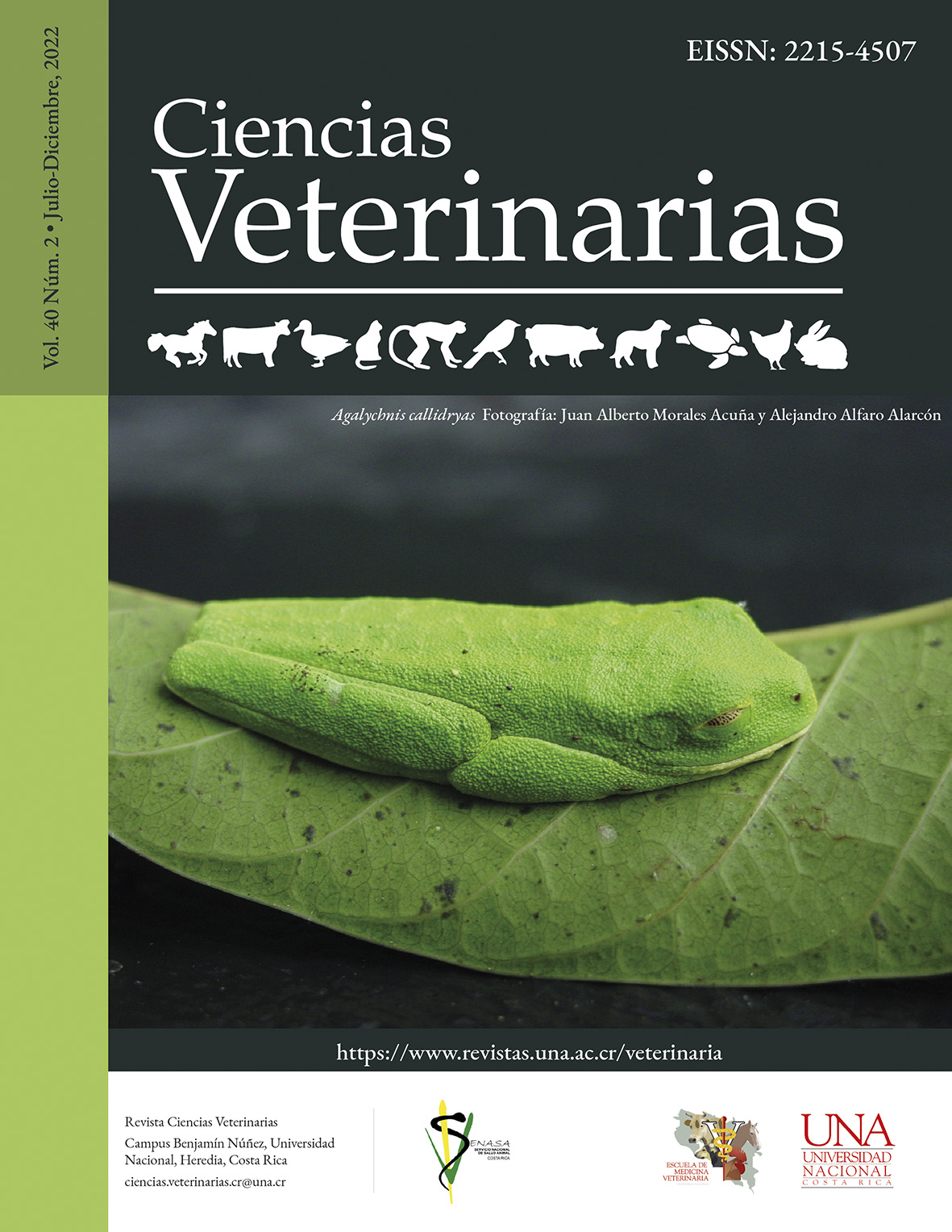Human ascariasis, an evolutionary complex relationship between host and parasite
DOI:
https://doi.org/10.15359/rcv.40-2.4Keywords:
Evolución, Ascariasis, Zoonosis, Terapia de Ascarídios, Ascaris suum, Ascaris LumbricoidesAbstract
La ascariasis es una enfermedad parasitaria que diezma la salud de cientos de miles de seres humanos, especialmente en los países en desarrollo. Sin embargo, la falta de profilaxis adecuada del parásito, asociado con un mayor riesgo de sufrir enfermedades inmunes, es un problema principalmente en los países desarrollados donde la prevalencia del parásito es muy baja. La relación evolutiva y los mecanismos por los cuales el parásito fue capaz de colonizar y establecerse en el huésped humano aún no se han descifrado. Del mismo modo, los mecanismos inmunes (proximales) de respuesta del huésped para eliminar o controlar el parásito no se entienden completamente. La comprensión de estos mecanismos nos permitirá establecer mejores tratamientos médicos, evitando efectos indeseables y más enfocados en el control de la parasitosis, así como para la terapia de estas enfermedades inmunológicas asociadas con la relación huésped-ascárido.
References
Allen, J. E. y Maizels, R. M. (2011). Diversity and dialogue in immunity to helminths. Nature Reviews. Immunology, 11(6), 375–388. https://doi.org/10.1038/nri2992
Anderson, T. J. C [T. J. C.], Romero-Abal, M. E. y Jaenike, J. (1993). Genetic structure and epidemiology of Ascaris populations: Patterns of host affiliation in Guatemala. Parasitology, 107(03), 319. https://doi.org/10.1017/S0031182000079294
Anderson, T. J. (2001). The dangers of using single locus markers in parasite epidemiology: Ascaris as a case study. Trends in Parasitology, 17(4), 183–188. https://doi.org/10.1016/s1471-4922(00)01944-9
Barendregt, J. J. (2002). Disability-adjusted Life Years (DALYs) and Disability-adjusted Life Expectancy (DALE). En J.-M. Robine, C. Jagger, C. D. Mathers, E. M. Crimmins y R. M. Suzman (Eds.), Determining Health Expectancies (pp. 247–261). John Wiley & Sons, Ltd. https://doi.org/10.1002/0470858885.ch13
Betson, M [Martha], Nejsum, P [Peter], Bendall, R. P [Richard P.], Deb, R. M. y Stothard, J. R [J. Russell] (2014). Molecular epidemiology of ascariasis: A global perspective on the transmission dynamics of Ascaris in people and pigs. The Journal of Infectious Diseases, 210(6), 932–941. https://doi.org/10.1093/infdis/jiu193
Briggs, N., Weatherhead, J., Sastry, K. J. y Hotez, P. J. (2016). The Hygiene Hypothesis and Its Inconvenient Truths about Helminth Infections. PLoS Neglected Tropical Diseases, 10(9), e0004944. https://doi.org/10.1371/journal.pntd.0004944
Casado-Maestre, M. D., Alamo-Martínez, J. M., Segura-Sampedro, J. J., Durán-Izquierdo, E., Marín-Gómez, L. M., Bernal-Bellido, C., Suárez-Artacho, G., Serrano-Díez-Canedo, J., Gómez-Bravo, M. Á. y Padillo-Ruiz, F. J. (2011). Ascaris lumbricoides as etiologic factor for pancreas inflammatory tumor. Revista Espanola De Enfermedades Digestivas : Organo Oficial De La Sociedad Espanola De Patologia Digestiva, 103(11), 592–593. https://doi.org/10.4321/S1130-01082011001100008
Cavallero, S., Snabel, V., Pacella, F., Perrone, V., D’Amelio, S. y Zhou, X.‑N. (2013). Phylogeographical Studies of Ascaris spp. Based on Ribosomal and Mitochondrial DNA Sequences. PLoS Neglected Tropical Diseases, 7(4), e2170. https://doi.org/10.1371/journal.pntd.0002170
Churcher, T. S. y Basanez, M.‑G. (2008). Density dependence and the spread of anthelmintic resistance. Evolution; International Journal of Organic Evolution, 62(3), 528–537. https://doi.org/10.1111/j.1558-5646.2007.00290.x
Coakley, G., Buck, A. H. y Maizels, R. M. (2016). Host parasite communications-Messages from helminths for the immune system: Parasite communication and cell-cell interactions. Molecular and Biochemical Parasitology, 208(1), 33–40. https://doi.org/10.1016/j.molbiopara.2016.06.003
Correale, J. (2014). Helminth/parasite treatment of multiple sclerosis. Current Treatment Options in Neurology, 16(6), 296. https://doi.org/10.1007/s11940-014-0296-3
Criscione, C. D., Anderson, J. D., Sudimack, D., Peng, W., Jha, B [Bharat], Williams-Blangero, S [Sarah] y Anderson, T. J. C [Timothy J. C.] (2007). Disentangling hybridization and host colonization in parasitic roundworms of humans and pigs. Proceedings. Biological Sciences, 274(1626), 2669–2677. https://doi.org/10.1098/rspb.2007.0877
Dall’ Orso, P, Cantou,V., Rosano K.,, De los Santos, K., Fernández,N., Berazategui,R., Giachetto, R. (2014). Ascaris lumbricoides. Complicaciones graves en niños hospitalizados en el Centro Hospitalario Pereira Rossell. Archivos De Pediatría Del Uruguay, 3(85), 149–154. http://www.scielo.edu.uy/pdf/adp/v85n3/v85n3a02.pdf
Diawara, A., Drake, L. J., Suswillo, R. R., Kihara, J., Bundy, D. A. P., Scott, M. E., Halpenny, C., Stothard, J. R [J. Russell] y Prichard, R. K. (2009). Assays to detect beta-tubulin codon 200 polymorphism in Trichuris trichiura and Ascaris lumbricoides. PLoS Neglected Tropical Diseases, 3(3), e397. https://doi.org/10.1371/journal.pntd.0000397
Dilks, C. M., Hahnel, S.R., Sheng, Q., Long, L., McGrath, P. T. y Andersen, E. C. (2020). Quantitative benzimidazole resistance and fitness effects of parasitic nematode beta-tubulin alleles. International Journal for Parasitology. Drugs and Drug Resistance, 14, 28–36. https://doi.org/10.1016/j.ijpddr.2020.08.003
Dold, C. y Holland, C.V [Celia V.] (2011). Ascaris and ascariasis. Microbes and Infection, 13(7), 632–637. https://doi.org/10.1016/j.micinf.2010.09.012
Dunsworth, H. M. (2010). Origin of the Genus Homo. Evolution: Education and Outreach, 3(3), 353–366. https://doi.org/10.1007/s12052-010-0247-8
Easton, A., Gao, S., Lawton, S.P., Bennuru, S., Khan, A., Dahlstrom, E., Oliveira, R.G., Kepha, S., Porcella, S. F., Webster, J., Anderson, R., Grigg, M. E., Davis, R. E., Wang, J. y Nutman, T. B. (2020). Molecular evidence of hybridization between pig and human Ascaris indicates an interbred species complex infecting humans. ELife, 9. https://doi.org/10.7554/eLife.61562
Frew, J. W. (2019). The Hygiene Hypothesis, Old Friends, and New Genes. Frontiers in Immunology, 10, 388. https://doi.org/10.3389/fimmu.2019.00388
Girgis, N. M., Gundra, U. M., Loke, P. y Knoll, L. J. (2013). Immune Regulation during Helminth Infections. PLoS Pathogens, 9(4), e1003250. https://doi.org/10.1371/journal.ppat.1003250
Holland, C. V [C. V.] y Smith, H. V. (Eds.). (2005). Toxocara: the enigmatic parasite. CABI. https://doi.org/10.1079/9781845930264.0000
Holt, R. D., Dobson, A. P., Begon, M., Bowers, R. G. y Schauber, E. M. (2003). Parasite establishment in host communities. Ecology Letters, 6(9), 837–842. https://doi.org/10.1046/j.1461-0248.2003.00501.x
Jackson, J. A., Friberg, I. M., Little, S. y Bradley, J. E. (2009). Review series on helminths, immune modulation and the hygiene hypothesis: Immunity against helminths and immunological phenomena in modern human populations: Coevolutionary legacies? Immunology, 126(1), 18–27. https://doi.org/10.1111/j.1365-2567.2008.03010.x
Johnston, C. J. C., McSorley, H. J., Anderton, S. M., Wigmore, S. J. y Maizels, R. M. (2014). Helminths and immunological tolerance. Transplantation, 97(2), 127–132. https://doi.org/10.1097/TP.0b013e3182a53f59
Kayes, S. G. (2005). Inflammatory and immunological responses to Toxocara canis. En C. V. Holland y H. V. Smith (Eds.), Toxocara: the enigmatic parasite (pp. 158–173). CABI. https://doi.org/10.1079/9781845930264.0158
Kondrashova, A., Seiskari, T., Ilonen, J., Knip, M. y Hyöty, H. (2013). The ‘Hygiene hypothesis’ and the sharp gradient in the incidence of autoimmune and allergic diseases between Russian Karelia and Finland. APMIS, 121(6), 478–493. https://doi.org/10.1111/apm.12023
Krücken, J., Fraundorfer, K., Mugisha, J. C., Ramünke, S., Sifft, K. C., Geus, D., Habarugira, F., Ndoli, J., Sendegeya, A., Mukampunga, C., Bayingana, C., Aebischer, T., Demeler, J., Gahutu, J. B., Mockenhaupt, F. P. y Samson-Himmelstjerna, G. von (2017). Reduced efficacy of albendazole against Ascaris lumbricoides in Rwandan schoolchildren. International Journal for Parasitology. Drugs and Drug Resistance, 7(3), 262–271. https://doi.org/10.1016/j.ijpddr.2017.06.001
Larson, G., Dobney, K., Albarella, U., Fang, M., Matisoo-Smith, E., Robins, J., Lowden, S., Finlayson, H., Brand, T., Willerslev, E., Rowley-Conwy, P., Andersson, L. y Cooper, A. (2005). Worldwide phylogeography of wild boar reveals multiple centers of pig domestication. Science (New York, N.Y.), 307(5715), 1618–1621. https://doi.org/10.1126/science.1106927
Leles, D., Gardner, S. L., Reinhard, K., Iniguez, A. y Araujo, A. (2012). Are Ascaris lumbricoides and Ascaris suum a single species? Parasites & Vectors, 5, 42. https://doi.org/10.1186/1756-3305-5-42
Leung, A.K.C., Leung, A.A.M., Wong, A.H.C. y Hon, K. L. (2020). Human Ascariasis: An Updated Review. Recent Patents on Inflammation & Allergy Drug Discovery, 14(2), 133–145. https://doi.org/10.2174/1872213X14666200705235757
Liu, G.‑H., Wu, C.‑Y., Song, H.‑Q., Wei, S.‑J., Xu, M.‑J., Lin, R.‑Q., Zhao, G.‑H., Huang, S.‑Y. y Zhu, X.‑Q. (2012). Comparative analyses of the complete mitochondrial genomes of Ascaris lumbricoides and Ascaris suum from humans and pigs. Gene, 492(1), 110–116. https://doi.org/10.1016/j.gene.2011.10.043
Loreille, O. y Bouchet, F. (2003). Evolution of ascariasis in humans and pigs: A multi-disciplinary approach. Memórias Do Instituto Oswaldo Cruz, 98(suppl 1), 39–46. https://doi.org/10.1590/S0074-02762003000900008
Maizels, R.M. (2009). Parasite immunomodulation and polymorphisms of the immune system. Journal of Biology, 8(7), 62. https://doi.org/10.1186/jbiol166
Maizels, R.M. y McSorley, H.J. (2016). Regulation of the host immune system by helminth parasites. The Journal of Allergy and Clinical Immunology, 138(3), 666–675. https://doi.org/10.1016/j.jaci.2016.07.007
McSorley, H.J. y Maizels, R.M. (2012). Helminth infections and host immune regulation. Clinical Microbiology Reviews, 25(4), 585–608. https://doi.org/10.1128/CMR.05040-11
Nadler, S. A. y Hudspeth, D. S. (2000). Phylogeny of the Ascaridoidea (Nematoda: Ascaridida) based on three genes and morphology: Hypotheses of structural and sequence evolution. The Journal of Parasitology, 86(2), 380–393. https://doi.org/10.1645/0022-3395(2000)086[0380:POTANA]2.0.CO;2
Nejsum, P [P.], Betson, M [M.], Bendall, R. P [R. P.], Thamsborg, S.M. y Stothard, J.R [J. R.] (2012). Assessing the zoonotic potential of Ascaris suum and Trichuris suis: Looking to the future from an analysis of the past. Journal of Helminthology, 86(2), 148–155. https://doi.org/10.1017/S0022149X12000193
Nejsum, P [Peter], Hawash, M. B. F., Betson, M [Martha], Stothard, J. R [J. Russell], Gasser, R. B. y Andersen, L.O. (2017). Ascaris phylogeny based on multiple whole mtDNA genomes. Infection, Genetics and Evolution : Journal of Molecular Epidemiology and Evolutionary Genetics in Infectious Diseases, 48, 4–9. https://doi.org/10.1016/j.meegid.2016.12.003
O’Lorcain, P. y Holland, C. V [C. V.] (2000). The public health importance of Ascaris lumbricoides. Parasitology, 121 Suppl, S51-71. https://doi.org/10.1017/S0031182000006442
Parker, W. y Ollerton, J. (2013). Evolutionary biology and anthropology suggest biome reconstitution as a necessary approach toward dealing with immune disorders. Evolution, Medicine, and Public Health, 2013(1), 89–103. https://doi.org/10.1093/emph/eot008
Peng, W. y Criscione, C. D. (2012). Ascariasis in people and pigs: New inferences from DNA analysis of worm populations. Infection, Genetics and Evolution : Journal of Molecular Epidemiology and Evolutionary Genetics in Infectious Diseases, 12(2), 227–235. https://doi.org/10.1016/j.meegid.2012.01.012
Peng, W., Yuan, K., Zhou, X., Hu, M., Abs EL-Osta, Y. G. y Gasser, R. B. (2003). Molecular epidemiological investigation of Ascaris genotypes in China based on single-strand conformation polymorphism analysis of ribosomal DNA. Electrophoresis, 24(14), 2308–2315. https://doi.org/10.1002/elps.200305455
Rito, T., Vieira, D., Silva, M., Conde-Sousa, E., Pereira, L., Mellars, P., Richards, M. B. y Soares, P. (2019). A dispersal of Homo sapiens from southern to eastern Africa immediately preceded the out-of-Africa migration. Scientific Reports, 9(1), 4728. https://doi.org/10.1038/s41598-019-41176-3
Roberts, L. S., Schmidt, G. D. y Janovy, J. (op. 2009). Gerald D. Schmidt & Larry S. Roberts’ foundations of parasitology (8th edition). McGraw-Hill Higher Education.
Schmid-Hempel, P. (2009). Immune defence, parasite evasion strategies and their relevance for ‘macroscopic phenomena’ such as virulence. Philosophical Transactions of the Royal Society of London. Series B, Biological Sciences, 364(1513), 85–98. https://doi.org/10.1098/rstb.2008.0157
Schneider-Crease, I. A., Blackwell, A. D., Kraft, T. S., Emery Thompson, M., Maldonado Suarez, I., Cummings, D. K., Stieglitz, J., Snyder-Mackler, N., Gurven, M., Kaplan, H. y Trumble, B. C. (2021). Helminth infection is associated with dampened cytokine responses to viral and bacterial stimulations in Tsimane forager-horticulturalists. Evolution, Medicine, and Public Health, 9(1), 349–359. https://doi.org/10.1093/emph/eoab035
Turner, J. D., Faulkner, H., Kamgno, J., Kennedy, M. W., Behnke, J., Boussinesq, M. y Bradley, J. E. (2005). Allergen-specific IgE and IgG4 are markers of resistance and susceptibility in a human intestinal nematode infection. Microbes and Infection, 7(7-8), 990–996. https://doi.org/10.1016/j.micinf.2005.03.036
Turner, J. D., Jackson, J. A., Faulkner, H., Behnke, J., Else, K. J., Kamgno, J., Boussinesq, M. y Bradley, J. E. (2008). Intensity of intestinal infection with multiple worm species is related to regulatory cytokine output and immune hyporesponsiveness. The Journal of Infectious Diseases, 197(8), 1204–1212. https://doi.org/10.1086/586717
van Kruiningen, H. J. y West, A. B. (2005). Potential danger in the medical use of Trichuris suis for the treatment of inflammatory bowel disease. Inflammatory Bowel Diseases, 11(5), 515.
Wammes, L.J., Mpairwe, H., Elliott, A.M. y Yazdanbakhsh, M. (2014). Helminth therapy or elimination: Epidemiological, immunological, and clinical considerations. The Lancet Infectious Diseases, 14(11), 1150–1162. https://doi.org/10.1016/S1473-3099(14)70771-6
Williams-Blangero, S [S.], Subedi, J., Upadhayay, R.P., Manral, D.B., Rai, D.R., Jha, B [B.], Robinson, E. S. y Blangero, J [J.] (1999). Genetic analysis of susceptibility to infection with Ascaris lumbricoides. The American Journal of Tropical Medicine and Hygiene, 60(6), 921–926.
Williams-Blangero, S [Sarah], Fenstad, M.H., Kumar, S. y Blangero, J [John]. (2013). Genetics of Human Host Susceptibility to Ascariasis. En Ascaris: The Neglected Parasite (pp. 315–340). Elsevier. https://doi.org/10.1016/B978-0-12-396978-1.00012-4
Yang, I.V. y Schwartz, D.A. (2012). Epigenetic mechanisms and the development of asthma. The Journal of Allergy and Clinical Immunology, 130(6), 1243–1255. https://doi.org/10.1016/j.jaci.2012.07.052
Zhou, C., Li, M., Yuan, K., Hu, N. y Peng, W. (2011). Phylogeography of Ascaris lumbricoides and A. Suum from China. Parasitology Research, 109(2), 329–338. https://doi.org/10.1007/s00436-011-2260-4
Downloads
Published
How to Cite
Issue
Section
License
Licensing of articles
All articles will be published under a license:

Licencia Creative Commons Atribución-NoComercial-SinDerivadas 3.0 Costa Rica.
Access to this journal is free of charge, only the article and the journal must be cited in full.
Intellectual property rights belong to the author. Once the article has been accepted for publication, the author assigns the reproduction rights to the Journal.
Ciencias Veterinarias Journal authorizes the printing of articles and photocopies for personal use. Also, the use for educational purposes is encouraged. Especially: institutions may create links to specific articles found in the journal's server in order to make up course packages, seminars or as instructional material.
The author may place a copy of the final version on his or her server, although it is recommended that a link be maintained to the journal's server where the original article is located.
Intellectual property violations are the responsibility of the author. The company or institution that provides access to the contents, either because it acts only as a transmitter of information (for example, Internet access providers) or because it offers public server services, is not responsible.







